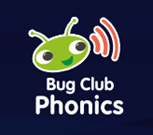Early Reading & Phonics (Bug Club Phonics)
|
At Stonebridge, we use the DfE validated systematic synthetic phonics programme, ‘Bug Club Phonics’ from Pearson (Activelearn) to deliver phonics in the Early Years and KS1. We also use decodable phonics books from Bug Club, which is our reading scheme in conjunction with PM books (which includes Cengage Learning Nelson books) to teach reading. |
 |
Intent
We use a systematic approach to the teaching of synthetic phonics to enable children to develop secure reading and spelling skills. It is proven that high quality phonics teaching is the best way to teach children to read, ‘the EEF considers phonics to be one of the most secure and best-evidenced areas of pedagogy, recommending all schools use a systematic approach to teaching it. There is convincing evidence of the value of systematic synthetic phonics (SSP)’ (The Reading Framework –Teaching the foundations of literacy January 2022). A strong emphasis on high quality teaching of phonics can substantially reduce the number of children at risk of falling below age-related expectations for reading.
Aims:
- Deliver high-quality phonic teaching which secures the crucial skills of word recognition that, once mastered, enable children to read fluently and automatically enable them to concentrate on the meaning of the text
- To establish consistent practice, progression and continuity in the teaching and learning of phonics and spelling throughout the school
- To support pupils with targeted, differentiated phonics and spelling work, in addition to the whole class teaching, so that all children are given sufficient support to progress and experience challenge at a level at which they can succeed
- To give children word work strategies that will enable them to become fluent readers and confident writers
Beginner readers should be taught:
- Grapheme phoneme correspondence in a clearly defined sequence as outlined below: -
- to apply the highly important skills of blending (synthesising) phonemes in the order in which they occur
- to apply the skills of segmenting words into their constituent phonemes to spell
- that blending and segmenting are reversible processes
Click the file below for more information

